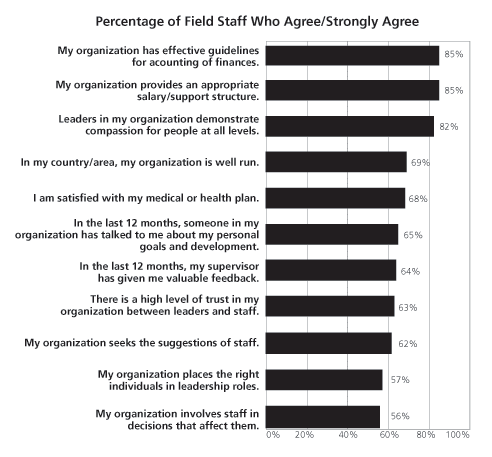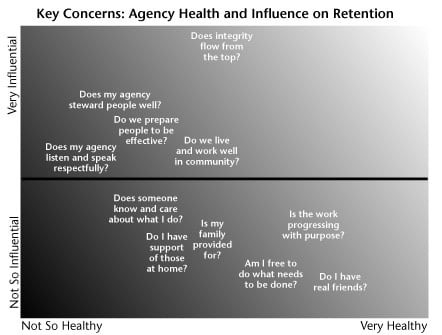Four Ways to Improve Field Staff Retention

by James Nelson
If you lead field staff, there are at least four things you can do to improve their likelihood of remaining on the field, productively and with your agency:
If you lead field staff, there are at least four things you can do to improve their likelihood of remaining on the field, productively and with your agency:
1. Give them specific feedback about their work or service.
2. Ask them about their goals in personal development.
3. Ask them for suggestions to improve as a team, department, or organization.
4. Be spiritually vital, reflecting Christ’s compassion and trustworthy character.
There are actually twenty-six things you can do that will help improve worker retention, according to data from the 2015 Engage study of international field workers serving with North American agencies. Engage is a multi-agency workplace engagement and satisfaction survey of international field workers serving with North American agencies. Authorized by the Mission Commission of the World Evangelical Alliance in 2006, Engage is an offering of Best Christian Workplaces Institute (BCWI) in partnership with Global Mapping International (GMI).
The first three are easy—you can do them this week. No need to wait for an annual review.
They are also among a group of eleven items most highly correlated with staff retention. Yet, unfortunately, more than one-third of field staff do not agree that their supervisor has given them valuable feedback in the past twelve months. More than a one-third do not agree that their organization seeks suggestions of staff. And more than one-third do not agree that someone has talked with them about their personal goals. This has held true across multiple editions of Engage involving more than 25 sending agencies and nearly 3,500 missionary respondents since 2006.
Retention Is a Kingdom Stewardship Issue
Some agencies spend much more effort and money mobilizing new workers than retaining current workers. One agency leader told me his agency focuses only on inflow to the personnel funnel (mobilization) and makes no effort to reduce outflow (attrition). “Workers leave,” he said. “and many of those do the right thing by leaving.”
Other agencies consider retention efforts as a losing battle to changing generational values. “No one commits anymore,” is their attitude. One agency that took part in Engage did away with the long-term staff label completely, considering all workers to be on renewable three-year terms.
The time and cost of recruiting, preparing, and placing cross-cultural workers on the field is substantial. Stewardship—as well as compassion for those who serve and support—dictates making an effort to help workers be as productive on the field for as long as they can. This is especially true as experts like Patrick Johnstone note that fruitfulness in church planting tends to be highest between the eighth and seventeenth years of a worker’s tenure (2011, 227).
What You Do Can Affect Retention
Despite changes in generational values, retention can be influenced. What you do makes a difference. Here’s how we know:
1. Retention varies from agency to agency. A decade ago, the ReMAP II study, involving more than sixty North American agencies, showed that long-term staff retention rates vary widely across agencies. One large segment of agencies reported retention rates that, sustained over a decade, would result in more than sixty percent of missionaries leaving. Another large group of agencies was on track to lose fewer than one-quarter of their workers over the same time. The lesson: Some agencies retain staff better than others.
2. Leadership behaviors and agency policies are linked to retention. The Engage survey has consistently shown that the retention rate of an agency can be reasonably predicted (or explained) on the basis of field staff attitudes about their leaders actions, policies, and systems. The lesson: Attrition isn’t just bad-fit people finding the door. It is an indicator of organizational effectiveness. When agencies are well-run, people stay.
Here’s where research-savvy people counter, “correlation does not equal causation.” Responsible researchers include this disclaimer. Some agencies may have higher attrition than others because of where and among whom they work. And some causes of attrition are outside of an agency’s control (although researcher efforts to remove “unpreventable” reasons for attrition have been unsatisfying).
Still, leaders ignore significant correlations at their own peril—and I think most would prefer to assume the validity of the hypothesis that field staff
respond to leadership, whether good or bad.
Workers also acknowledge agency influences on attrition. One Engage respondent reflected the following to his/her agency:
Attrition is high. …It seems people feel there is a lack of vision and training for accomplishing the task. A lot of time is spent on secondary issues. Eventually, this lack of vision and skills seems to make people question their calling and purpose, which leads to a lack of excitement about our work, and eventually to burnout and going home.
Eleven Actions Linked to Retention
The challenge for many leaders is knowing how and where to take action. So many issues can influence continuing service. “Make everything better,” isn’t helpful. In which areas are improvements likely to “move the dial?” In which areas is sustained excellence essential?
The Engage study includes seventy-four agreement measures, including sixty-seven job/agency assessment items and seven overall measures (such as intention to stay on staff or recommend the organization to others).
To see which items were linked most strongly to retention, we ran small-sample rank correlations (Kendall’s Tau) for three-year agency retention rate (provided by six of seven agencies in the 2015 study) and mean agreement ratings for each agency. Results showed highly significant (ninety-five percent confidence) positive correlations for eleven of the sixty-seven survey items and moderately significant (ninety percent confidence) positive correlations for fifteen other survey items. Significant positive correlations were also noted for all seven overall measures.
The eleven highly correlated items include:
• Leaders in my organization demonstrate compassion for people at all levels.
• There is a high level of trust in my organization between leaders and staff.
• My organization places the right individuals in leadership roles.
• In my country/area, my organization is well run.
• My organization seeks the suggestions of staff.
• My organization involves staff in decisions that affect them.
• In the last 12 months, my supervisor has given me valuable feedback.
• In the last 12 months, someone in my organization has talked to me about my personal goals and development.
• My organization provides an appropriate salary/support structure.
• My organization has effective guidelines and practices for accounting of finances.
• I am satisfied with my medical or health plan.
How Agencies Are Doing on Key Retention Measures
While all of these items are linked to retention, mission agencies vary on their performance. For some items, there is much room for improvement. For others, results suggest the need for ensuring continued strength.
The chart below shows the proportion of 2015 respondents who “Strongly Agree” or “Agree” with each item. These are results from 1,771 workers among seven agencies, including a mix of smaller/larger and denominational/non-denominational agencies.
Retention Issues on the Rise
In the prior edition of Engage, salary and benefits were not significantly correlated with agency retention. But in 2015, both emerged as significant.
Most field staff are satisfied with their salary structure. Along with financial policies and compassionate leadership, it is one of three items for which workers have high threshold standards—items that are expected to be present and impactful when perceived to be absent.
Satisfaction is considerably lower with medical benefits, an area where costs have skyrocketed and many agencies are seeking or weighing alternatives. Results suggest these decisions are likely to influence field staff decisions about continuing service.
One Engage respondent said to his/her agency:
Current medical insurance has caused a real drain on our finances during furlough times. They have been so slow/absent in reimbursement that we have been very hesitant to avail ourselves of medical attention even if there was a need to do so.
Big decisions like health care are important. So are issues of leadership character, such as demonstrating compassion for all employees.
Making appropriate leadership appointments and involving staff in issues that affect them are key issues. Both were among the twelve lowest-rated survey items in 2015, as they were in the 2006-2007 edition of Engage. In fact, personnel practices as a cluster are linked to continuing service. Related items were moderately correlated with retention, including selection and appointment of well-qualified new staff and provision of opportunities for single staff.
When the wrong personnel decisions are made or are made in the wrong way or by the wrong people, field staff are deeply affected. One Engage respondent said to his/her agency leaders: “Include teammates in decision making when it comes to matters of a fellow teammate’s life and stop telling us “Trust me in this!”
Having surveyed with more than seven hundred ministry organizations internationally, the Best Christian Workplace Institute (www.bcwinstitute.org) reveals that increased staff engagement and retention are by-products of a flourishing culture.
One of the major shifts I have seen in ministry organizations is a focus on creating a flourishing staff culture,” says Al Lopus, president, and cofounder of BCWI. He adds, “The first step is regularly measuring the progress toward that goal on an annual or bi-annual basis.”
Be Willing to Take the First Step
Insights from Engage underscore the issues that are linked to field staff retention. Some of the key items are not difficult to address—yet they can easily fall through the cracks. For globally distributed organizations, effective communication is frequently an issue. Field workers place high value on international leaders intentionally communicating about organizational issues, but they also value personal communication.
In particular, missionaries value having their input sought, receiving specific feedback on their service, and discussing personal development goals. As one worker wrote:
I have always appreciated (my organization’s) support of personal and ministry development. The conferences we used to hold were so key in stimulating growth in areas I needed for ministry and spiritual vitality.
Each of these items is strongly connected to retention and easy to address. But each requires intentionality and the will to place the important ahead of the urgent.
At the organization level, asking for staff suggestions can be done informally or formally. The Engage study remains available to agencies ready to take the formal route—the survey considers field worker security concerns and questions that have been vetted by mission personnel officers. Deliverables include an agency-specific report, benchmark data compiled from other mission organizations, and a phone consultation from Best Christian Workplaces Institute.
Staff retention is a big matter deserving of small, initially positive steps. The four action points at the top of this article can be a place to begin. While increased field staff retention requires ongoing attention and effort, the research is in key issues that are both identifiable and measurable. That alone is a positive outcome every ministry organization can build upon.
References
Global Mapping International. 2009. The Engage Study Executive Summary. Available at: www.gmi.org/files/2114/1108/6301/Engage_Executive_Summary-2.pdf
Johnstone, Patrick. 2011. The Future of the Global Church. Downers Grove, Ill.: InterVarsity Press.
….
James Nelson (pseudonym) is vice president of Global Mapping International and mission research consultant for Missio Nexus. A complete list of all sources used in writing this article is available by emailing jim@gmi.org.
EMQ, Vol. 51, No. 4 pp. 440-445. Copyright © 2015 Billy Graham Center for Evangelism. All rights reserved. Not to be reproduced or copied in any form without written permission from EMQ editors.


